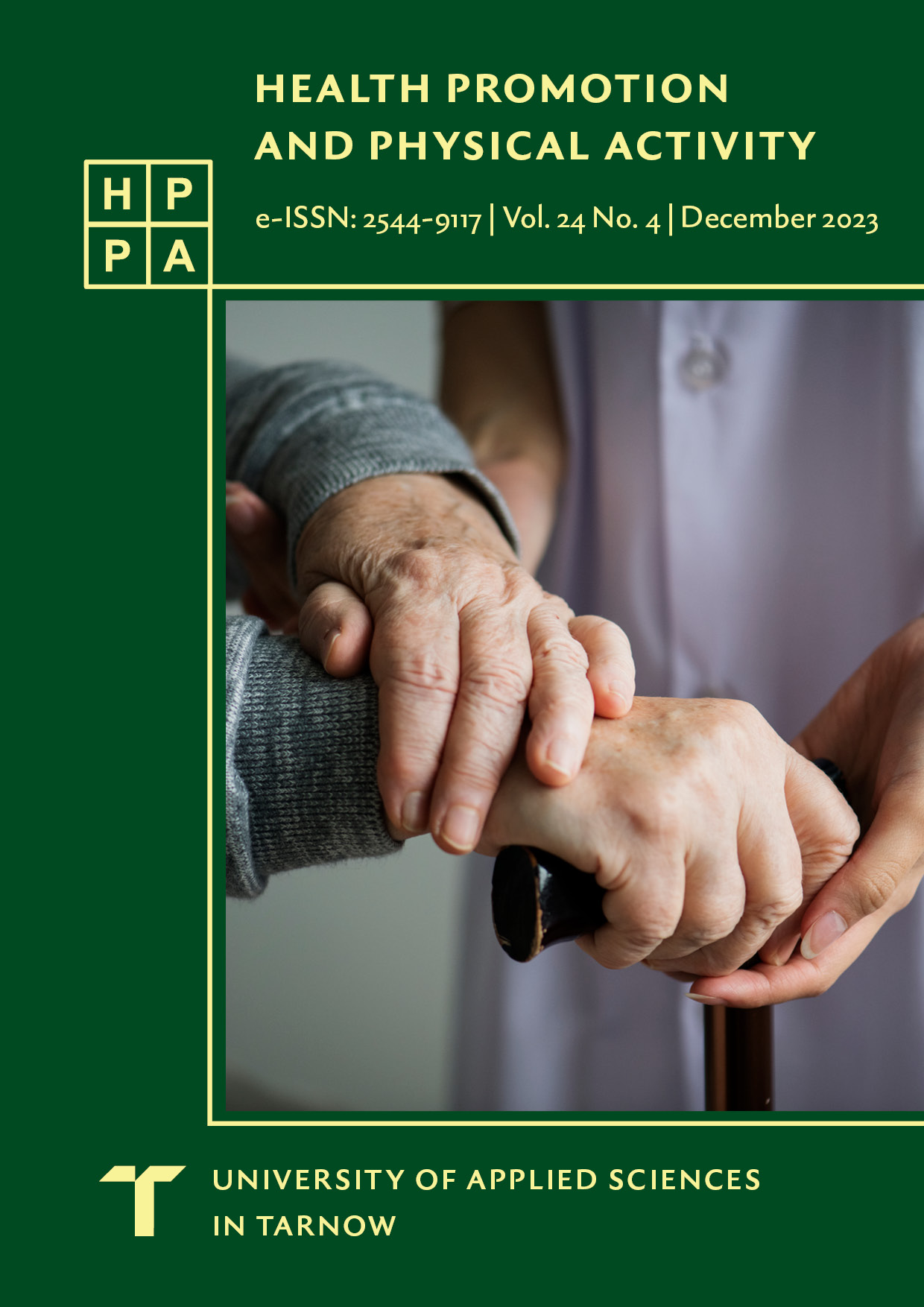Changes in gait parameters and pelvic movement during gait under the influence of light loads carried symmetrically or asymmetrically — preliminary research
DOI:
https://doi.org/10.55225/hppa.573Keywords:
walking, pelvic movements, gait symmetry, carrying a bag, backpackAbstract
Introduction: Walking is one of the basic human activities. Taking care of the correct gait pattern is important for maintaining proper body posture and preventing dysfunctions of the musculoskeletal system. Since walking often involves carrying a load, the study aimed to evaluate changes in gait parameters and pelvic movement during gait under the influence of light loads carried symmetrically or asymmetrically in a bag or backpack.
Material and methods: The group of 11 women and 15 men aged between 19 and 25 were examined. The BTS G-Sensor device was used. The basic gait parameters were examined, as well as the symmetry coefficient of pelvic motion and the range of pelvic motion in each of the three planes. The test involving walking 30 meters was repeated four times: while walking without a load, with an additional load worn in a backpack on both shoulders, in a bag on the right shoulder, or in a bag worn diagonally on the left shoulder. Each time the load was equal to 10% of the participantʼs body weight.
Results: Walking speed, stride length to body height ratio, gait symmetry coefficient, and left and right foot propulsive speed did not change significantly during walking while carrying a load of 10% of body weight, regardless of the method of carrying a bag or backpack.
Conclusions: Although carrying a light bag or backpack does not change the basic gait parameters, even such a small load reduces the symmetry of pelvic movement and the range of pelvic motion in the frontal and transverse planes during walking.
Downloads
References
Negrini S, Carabalona R. Backpacks on! Schoolchildren’s perceptions of load, associations with back pain and factors determining the load. Spine. 2002;27(2):187-195. doi: 10.1097/00007632-200201150-00014. DOI: https://doi.org/10.1097/00007632-200201150-00014 Google Scholar
Hossain FMA, Tonima MA. A study on the effects of heavy backpack and development of a preventative prototype. J Sensors. 2017;2017:1-10. doi: 10.1155/2017/9419373. DOI: https://doi.org/10.1155/2017/9419373 Google Scholar
Rai A, Agarawal S. Back problems due to heavy backpacks in school children. IOSR J Humanit Soc Sci. 2013;10(6):22-26. https://www.iosrjournals.org/iosr-jhss/papers/Vol10-issue6/D1062226.pdf?id=6253. DOI: https://doi.org/10.9790/0837-1062226 Google Scholar
Malinowska-Borowska J, Flajszok K. Do the requirements included in the regulation on health and safety at school effectively prevent children from carrying too heavy schoolbags? Med Pr. 2020;71(6):687-697. doi: 10.13075/mp.5893.00998. DOI: https://doi.org/10.13075/mp.5893.00998 Google Scholar
Smith B, Ashton KM, Bohl D, Clark RC, Metheny JB, Klassen S. Influence of carrying a backpack on pelvic tilt, rotation, and obliquity in female college students. Gait Posture. 2006;23(3):263-267. doi: 10.1016/j.gaitpost.2005.02.009. DOI: https://doi.org/10.1016/j.gaitpost.2005.02.009 Google Scholar
Hyung E-J, Lee H-O, Kwon Y-J. Influence of load and carrying method on gait, specifically pelvic movement. J Phys Ther Sci. 2016;28(7):2059-2062. doi: 10.1589/jpts.28.2059. DOI: https://doi.org/10.1589/jpts.28.2059 Google Scholar
Geon-Mo Kim, Lee S-H, Lee D-Y, Hong J-H, Kim J-S, Yu J-H. The comparison between before and after cross bag walking intervention on gait parameter and center of pressure. Ann Rom Soc Cell Biol. 2021;25(1):911-917. Google Scholar
Talbott NR, Bhattacharya A, Davis KG, Shukla R, Levin L. School backpacks: It’s more than just a weight problem. Work. 2009;34(4):481-494. doi: 10.3233/WOR-2009-0949. DOI: https://doi.org/10.3233/WOR-2009-0949 Google Scholar
Heuscher Z, Gilkey DP, Peel JL, Kennedy CA. The association of self-reported backpack use and backpack weight with low back pain among college students. J Manipulative Physiol Ther. 2010;33(6):432-437. doi: 10.1016/j.jmpt.2010.06.003. DOI: https://doi.org/10.1016/j.jmpt.2010.06.003 Google Scholar
Hung-Kay Chow D, Kit-Fong Hin C, Ou D, Lai A. Carry-over effects of backpack carriage on trunk posture and repositioning ability. Int J Ind Ergon. 2011;41(5):530-535. doi: 10.1016/j.ergon.2011.04.001. DOI: https://doi.org/10.1016/j.ergon.2011.04.001 Google Scholar
Hardie R, Haskew R, Harris J, Hughes G. The effects of bag style on muscle activity of the trapezius, erector spinae and latissimus dorsi during walking in female university students. J Hum Kinet. 2015;45(1):39-47. doi: 10.1515/hukin-2015-0005. DOI: https://doi.org/10.1515/hukin-2015-0005 Google Scholar
Shamsoddini A, Hollisaz M, Hafezi R. Backpack weight and musculoskeletal symptoms in secondary school students, Tehran, Iran. Iran J Public Health. 2010;39(4):120-125. Google Scholar
Pascoe DD, Pascoe DE, Wang YT, Shim DM, Kim CK. Influence of carrying book bags on gait cycle and posture of youths. Ergonomics. 1997;40 (6):631-640. doi: 10.1080/001401397187928. DOI: https://doi.org/10.1080/001401397187928 Google Scholar
Fałatowicz M, Jankowicz-Szymańska A, Kaczor A. The effect of carrying a light shoulder bag and cross bag on trunk positioning in young adults. J Kinesiol Exerc Sci. 2020;30(90):55-62. doi: 10.5604/01.3001.0014.7771. DOI: https://doi.org/10.5604/01.3001.0014.7771 Google Scholar
Downloads
Published
How to Cite
Issue
Section
License
Copyright (c) 2024 Katarzyna Wódka, Sylwia Łachut, Agnieszka Jankowicz-Szymańska

This work is licensed under a Creative Commons Attribution-ShareAlike 4.0 International License.









